
 Baseball Pilgrimages Baseball Pilgrimages
| Stadium Attendance |
| Year | Total | Average |
2016
2015
2014
2013
2012
2011
2010
2009
2008
2007
2006
2005
2004
2003 |
161,121
180,191
177,531
168,026
184,983
186,345
193,061
183,750
222,168
232,674
232,259
232,187
245,724
246,718 |
2,405
2,689
2,573
2,625
2,803
2,781
2,839
2,827
3,366
3,372
3,416
3,465
3,723
3,979 |
| * Attendance figures listed are the regular season totals drawn by the Rome Braves at State Mutual Stadium |
| Travel Info |
Nearest Major Airports:
Hartsfield-Jackson Atlanta International (83.4 miles)
Birmingham-Shuttlesworth International (117.5 miles)
Nearest Pro Ballparks:
SunTrust Park in Atlanta, GA (65.5 miles)
AT&T Field in Chattanooga, TN (74.8 miles)
Coolray Field in Lawrenceville, GA (94.8 miles)
|
| Ballpark Directory |
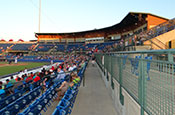
See all the ballparks, like Rome's State Mutual Stadium, in which professional baseball is played. Our Pro Baseball Ballpark List includes every current one.
|
Baseball Pilgrimages
Where the pursuit of baseball never ends.
[Site Map]
|
|
Inspiration comes from obvious places in the Georgia city of Rome. The world renowned Italian city is indeed why it's named so, but when opting to build a "coliseum for use as a baseball stadium," as the wording stated in a 2001 ballot referendum whose passage led to the construction of State Mutual Stadium, the Romans here looked a lot closer to home for a structure to emulate, opting to borrow heavily from the blueprints for the ballpark that opened in 2001 in Lexington, Ky.
Thus, the Rome, Ga. baseball coliseum bears a strong resemblance to Whitaker Bank Ballpark, the home of the Lexington Legends, who like the Rome Braves are also members of the South Atlantic League. But while the same design-build team produced both venues and the cost was similar, State Mutual Stadium is really Lexington-lite as it just doesn't have as much "stuff." For example, Rome's ballpark has no permanent seats or significant structures beyond the outfield fences like you'll find in Lexington, and although the grandstand of the two ballparks are nearly identical there are a dozen less suites ringing the top of it at State Mutual Stadium. Otherwise, the main seating structures contain the same signature features, with greatly enlarged entrance portals at first and third base and a sizable restaurant with indoor and outdoor seating found directly behind home plate. The drawbacks are the same too, as the cross aisle within the grandstand is too narrow in both stadiums and the modern concept of the concourse having views of the playing field is absent.
So there's not too much unique at the Braves' version of the ballpark, which is a perfectly fine place to see a game and is most distinctive in its own right for the berm that wraps around the right field foul pole. There's also an additional patch of grass on the left field line for the folks who want to sit closer to the infield for the general admission price. And although it has no view of the field, the wonderfully well-done history of baseball in Rome display behind home plate is very much worth a perusal. Certainly it's worth checking out "when in Rome."
As for being in Rome, the home of the team based there isn't particularly memorable. State Mutual Stadium is simply a nice, fairly typical example of the modern yet classic ballpark that has defined where minor league baseball is played in the 21st century. Aside from the history documented inside of its front gates and appropriately excellent food (meaning the Southern staples of BBQ and sweet tea), there's not a strong sense of place, so State Mutual Stadium doesn't stick out from the pack of parks that are in other places with less worldly names.

Location
State Mutual Stadium is found on a mostly empty stretch of highway very close to the Oostanaula River. A tall, brick pillar supported marquee stands sentry at the ballpark's main entrance, which is at the intersection of Veterans Memorial Highway and Riverside Parkway. Veterans Memorial Highway, a bypass also known as State Loop 1, runs parallel to State Mutual Stadium, which is about a 5-minute drive from downtown Rome. Along the access road that leads to and from the stadium (Braves Boulevard) is an Italian restaurant. Across the street from the marquee is a Fuddruckers and the buildings you see near it are numerous dental offices and the Floyd County Board of Education Central Office. That's the extent of development in the immediate vicinity.
What you won't find anywhere near the stadium is an Interstate. None pass through Rome; I-75 is as close as it gets, and that's nearly 30 miles away. Quite close to, but not visible from, State Mutual Stadium is the Oostanaula River, which weaves through farmland that can be glimpsed beyond the outfield fence. The Heritage Park Trail traces the river on its stadium side, and the stadium serves as one of the trailheads for the bike/pedestrian riverfront path, which covers about 4½ miles. A mere mile and a half west of the stadium, but just outside of Rome's city limits in Mount Berry, is the 27,000-acre campus used by the 2,000+ students that attend Berry College. If you ask someone in Atlanta, which is about 75 miles away, to name something in Rome the college would most likely be it.
Parking
A fully paved parking lot wraps the stadium. Spanning foul pole to foul pole, it's much bulkier on the third base side and for most games that's where cars are routed to, as spaces reserved for season ticket holders and the handicapped are mostly what's on the first base side of the stadium lot, which has a fee to park in.
If overflow parking is needed, a large lot beyond right field can be used. Baseball is really the secondary purpose for that paved lot, as it's used year-round by users of the Heritage Park Trail, the multi-use trail for which the stadium area is a trailhead. This parking lot is on the banks of the Oostanaula and is a short walk to the stadium. Stadium stuff and vendors park there. On most nights, they are the only baseball-related traffic to park in the stadium's auxiliary and trail's main lot.
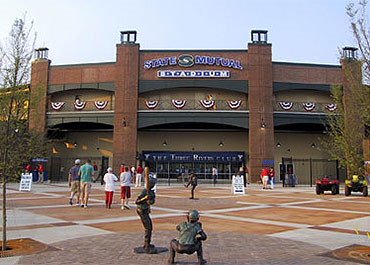 |
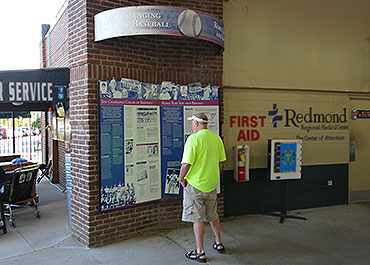 |
| There's certainly a lot to look at near the front gates of Rome's ballpark, which features an attractive brick and stucco facade with dark green steel mixed in. The scene of kids playing baseball is seen in the entry plaza, while the history of baseball in Rome-Floyd County is documented on very informative panels placed on brick pillars in the concourse area behind home plate. |
Features
Three statues of kids playing baseball are prominently featured in the plaza in front of the stadium. The classic scene shows a young pitcher in his leg kick with the equally youthful hitter and catcher prepared for the pitch. Appropriately sized brick circles are inlaid within the plaza's pavement to denote the areas where the classic pitcher vs. batter confrontation happens.
The stadium has six entrance gates but four of them (2-5) are bunched together in the plaza area behind home plate, which essentially means there are four main gates. Just inside the stadium on the concourse between gates 3 and 4 is a statue of a pitcher in his high leg kick, which the plaque accompanying the life-sized adult statue says is "dedicated to all who have contributed to the heritage of baseball in Rome and Floyd County."
Very wide entrance portals are on the first and third base side of the grandstand. If not for them, there would be no views of the playing field from the main concourse, which is behind grandstand.
Seating is split between a single grandstand and two berms. Most of the lawn seating is available on the manmade hillside aside the right field line and beyond the right field fence. A much smaller and flatter grass section is not too far down the left field line. The partially symmetrical grandstand is divided into unequal lower and upper halves by a fairly narrow cross aisle. The lower sections have up to 8 rows of seats, the staircase-accessed upper sections have about double that. The lower seating bowl has more sections (3) on its first base side and is thus unbalanced. The upper stands are symmetrical.
On five brick pillars within the concourse behind home plate are panels that detail the history of baseball in the area. With a combination of text and pictures, the thoroughly researched displays cover such topics as the once flourishing Northwest Georgia Textile League and Rome's first professional baseball game (in 1910) and ballpark (Hamilton Park).
A restaurant is behind home plate. Embedded into the grandstand, it's called The Three Rivers Club as a tribute to Rome's three rivers (the Coosa, Etowah and Oostanaula) and many of its tables have views of the field, although they are generally obstructed, especially for those sitting in the actual dining room, which includes a no-view-of-the-field bar in the first base side corner. A very limited amount of outdoor tabletop seating is available, but the diners and drinkers at the five or so hightop bar-style tables have to deal with foot traffic on the aisle in front of them. Those dining inside are able to watch the closed-circuit feed of the game on multiple flat screen TVs. While the restaurant/bar is supposed to be restricted to club/suite ticket holders, it's often open to all fans.
Despite the presence of three boards, only one keeps score. It's behind the left-center field fence, where it's aside the Braves bullpen, and includes a live video-capable screen. Behind the visiting team's bullpen in right-center is a message board-style strip that usually shows some stats and positioned above it in backlit blue lettering is GO BRAVES. Angled towards the field not far from the grandstand's third base side end is a screen that generally shows upcoming promotions and other non-game info on a sponsor-framed full-color board that is designed to tie into the nautical theme of the area.
In the deep recesses of the right field corner is an official kids play area, although it has just a few inflatables. From a permanent picnic pavilion nearby groups can be served meals. The grass seating in right field goes by the name Home Run Hill and upon the concourse in that part of the outfield are plenty of additional picnic tables where, unlike the kid and pavilion areas, you can actually watch the game from.
Food/drink destinations have been created just beyond each end of the grandstand. On the first base side is a "BBQ Barn," while a "marina" with seating at an actual boat can notably be found on the third base side. Barbeque, obviously, and other Southern-style specialties can be found in the picnic table and drink rail-filled barn. A shrimp bucket is the food item available from the bar in the marina, which has a handful of dockside-style tables in addition to the stools situated around the permanently docked small speedboat.
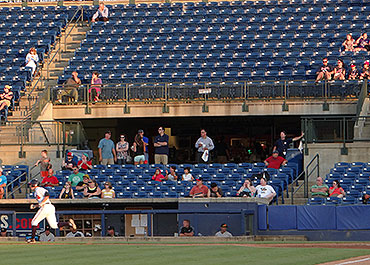 |
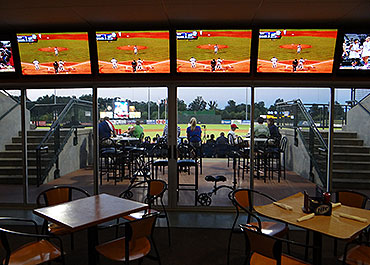 |
| Quite wide portals are found on the grandstand's first and third base side. Those openings are the only place on the main concourse from which fans can see the field. The dining room of the stadium restaurant is directly behind home plate, but to watch the game from in there you have to look up at the wall-mounted TVs. |
State Mutual Stadium Facts, Figures & Footnotes
Construction cost: $15 million
Financing: Local voters approved a special purpose, local option sales tax (SPLOST) on November 6, 2001, that imposed a countywide 1% sales and use tax increase over a 15-month period to amass $15 million. The referendum passed by a 7,163 to 7,021 count and the extra 1-cent sales tax was collected from April 1, 2002 through June 30, 2003.
Architect: Stadium Consultants International/Brisbin Brook Beynon, a Canadian firm based in Toronto
General contractor: H&M Company of Jackson, TN
Ceremonial groundbreaking took place on April 11, 2002, which was exactly one year prior to the stadium's first game and the groundbreaking date was deliberately chosen for that reason.
Owned by Floyd County. Rome is the largest city in Floyd County and is also the county seat.
Naming rights: State Mutual Insurance Co., which was founded and is still headquartered in Rome, is paying $1.8 million over the lifetime of an 18-year contract, making the average annual value of the deal worth $100,000. The name of the stadium was announced on February 28, 2003 and the contract stipulates that the county receive 40%, and the Braves 60%, of the net revenue from the naming rights fee, which means the actual total received by Floyd County is less than the percentages would seemingly dictate. For example, the county's first year take was a mere $8,286 after deductions were calculated from the gross revenue amount.
The lease agreement between the Atlanta Braves, owner of the Rome Braves, and Floyd County is for 18 years and includes three 4-year options to extend the lease that can be exercised by the team. In lieu of rent, the county receives a percentage of season ticket revenue: 35% of the revenue from $175,001-$350,000 in season ticket sales and 25% of such revenue for the $350,001-$525,000 range. Beyond that, no rent is paid and the money the county receives must be placed into a capital maintenance fund for necessary improvements to and maintenance of the facility.
Has 14 luxury suites. Each includes outdoor stadium seating and is designed to hold 20 people.
A terrace is at the top of the first base grandstand. It's for group use and can accommodate 20 to 200 people. The terrace has lots of open-air table seating plus a covered bar in its rooftop setting.
The Braves' (home team) dugout is on the third base side of the stadium.
The buildings down the left field line house both team clubhouses and batting cages.
Has outfield dimensions that were chosen to replica those at Turner Field and, just like in Atlanta, all of the seats in the stadium are blue. Two musical traditions from "The Ted" are copied at State Mutual Stadium: the same jingle plays when a Rome Brave circles the bases after hitting a home run and John Denver's "Thank God I'm A Country Boy" is played following "Take Me Out to the Ball Game" during the middle of the 7th inning.
Adjacent to the stadium is what's officially called the Braves Miracle Field of Rome. It opened in April 2012 and is a special rubberized field that allows many children and adults with disabilities the opportunity to play baseball. The Rome Braves manage and maintain the Miracle Field, which is at the back corner of the third base side parking lot.
Official Ballpark Firsts
First game: April 11, 2003; the Rome Braves beat the Savannah Sand Gnats, 4-3, before an announced crowd of 5,105
The ceremonial first pitch was thrown by Ernie Johnson, who had pitched for eight seasons with the big league Braves when they were in Boston and Milwaukee then later became the team's inaugural play-by-play announcer in Atlanta, and wound up broadcasting Atlanta Braves games for over three decades.
Other official ballpark firsts (all of which occurred on 4/11/03):
| Pitch | Batter | Hit (single) | Home Run | Winning Pitcher | Losing Pitcher | Save |
| Anthony Lerew | Reggie Fitzpatrick | Onil Joseph | Larry Broadway | Fernando Tadefa | Jose Rodriguez | Brad David |
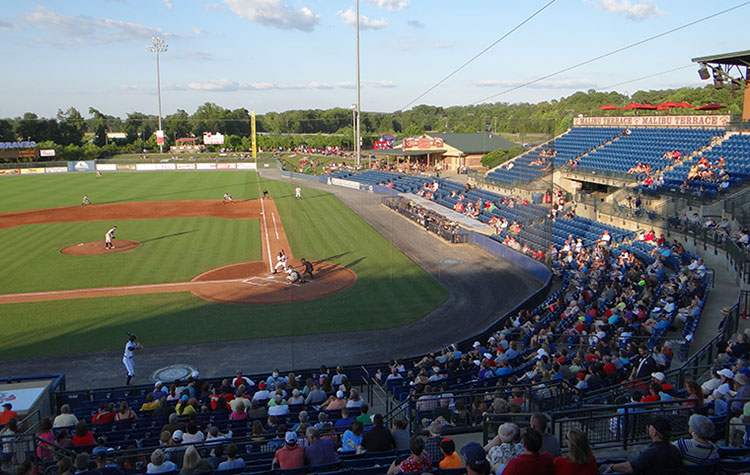
|










